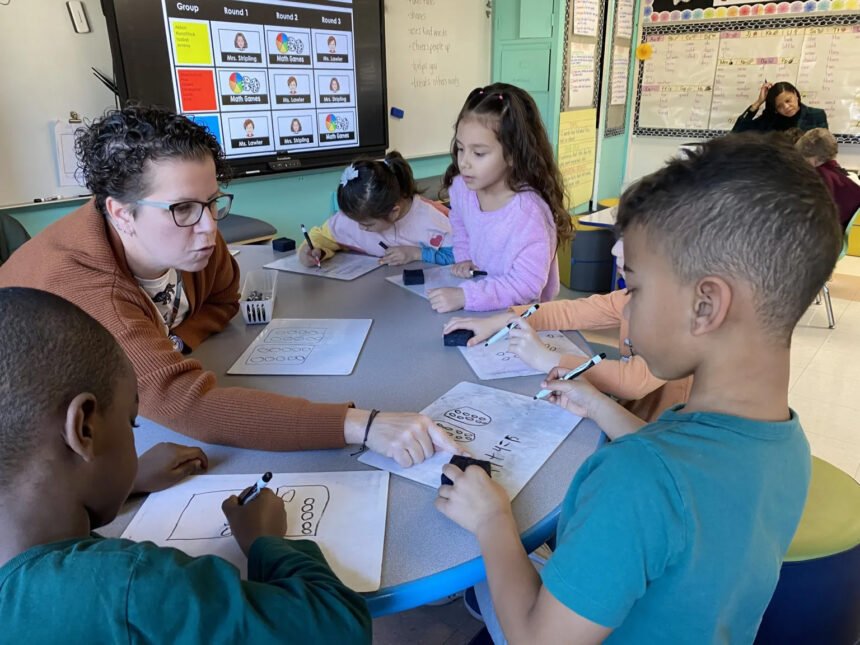In New Jersey, fewer than half of 6- and 7-year-olds in special education spend the vast majority of their day with their classmates without disabilities. That might change, though, because a state special education advisory group has pledged to examine the issue.
Earlier this year, a Hechinger Report investigation revealed New Jersey is the worst in the nation when it comes to what’s known as inclusion — measured by how often students of all abilities are learning alongside one another in the classroom for at least 80 percent of the day. For young students, specifically, the rate is especially low.
In September, the council that advises New Jersey state education officials on special education issues announced plans to focus on the placement of young children with disabilities this year. It will examine how the state trains educators and administrators and study whether there’s a link between a child’s disability and their placement.
Related: A lot goes on in classrooms from kindergarten to high school. Keep up with our free weekly newsletter on K-12 education.
Nationwide, 68 percent of students with disabilities spend at least 80 percent of the school day learning alongside peers without disabilities, according to The Hechinger Report’s analysis of federal data. New Jersey has the lowest rate at 45 percent.
And just 48.5 percent of 6- and 7-year-olds with disabilities in New Jersey spend the vast majority of their day in a general education classroom, compared with nearly three-quarters nationally. Researchers say including those young students is often easier and more beneficial — while observers say the data shows New Jersey isn’t doing enough to protect children’s rights to try learning in inclusive classrooms in their first years of schooling.
Vin Gopal, a New Jersey senator and chair of the state Senate Education Committee, called the statistics “extremely disconcerting” and said they demonstrate that New Jersey must make “fundamental changes.”
“Evidence clearly indicates that students with disabilities, and often general education students as well, benefit profoundly from inclusive educational settings, and understanding that, New Jersey needs to do better,” Gopal, a Democrat who also serves as Senate majority conference leader, said in an email.
Under federal law, students have the right to learn alongside their peers without disabilities as much as possible. Special education experts say most students, especially young ones, can learn in a general education classroom with proper support and accommodations.

Although there are some promising signs of change in New Jersey, advocates and parents say there are still many obstacles at both the state level and at the federal level as the Trump administration continues to target the Department of Education.
One potential factor behind New Jersey’s low inclusion rates: how exactly districts write and enforce individualized education programs, or IEPs. These agreements lay out what kinds of services students are required to receive, and where.
Related: Tracking Trump: His actions to dismantle the Education Department, and more
Between 2016 and 2023, state officials determined at least 50 school districts — nearly a third of those monitored — at times failed to justify where they placed students with disabilities, according to a Hechinger Report review of state records. All school districts undergo monitoring every six years in New Jersey, according to state policy.
That’s a violation of New Jersey law, which requires IEP teams — whose members include school officials and educators — to annually review and provide a written explanation for student placements. For example, if a student is assigned to be in a separate classroom, their IEP should spell out why they can’t be taught in an inclusive classroom with additional support. And IEP teams are required to come up with plans to return students to classrooms with peers without disabilities, if possible.
Districts are cited even if there is insufficient documentation in only one student’s IEP, according to Michael Yaple, a spokesperson for the New Jersey Department of Education. In a statement, Yaple said the department is focused on making sure all decisions about a child’s placement “are individualized, federally compliant, and regularly reviewed to promote inclusive opportunities.”
To Gopal, problems with IEPs point to a need for more parental involvement in these decisions and better procedures to help parents object if they disagree about their child’s placement.
“Failure to justify these placements should not be acceptable,” Gopal said. He has long focused on addressing problems with special education in the state, including sponsoring a bill last year to improve communication between schools and parents.
The bill, which was signed into law in the summer, will require districts to provide parents with details about their student’s academic progress ahead of IEP meetings, and it will also require that the state launch a working group to monitor parental involvement.
Efforts to train teachers in how to teach in inclusive classrooms are growing too.
The New Jersey-based nonprofit All in For Inclusive Education received interest from three times as many school districts as it could serve in this year’s round of applications for its New Jersey Inclusion Project program, which provides support to districts looking to improve inclusion rates. About a dozen districts were chosen to receive the training.
Related: New Jersey sends kids with disabilities to separate schools more than any other state
Advocates hope rising interest means New Jersey is on the cusp of taking the steps that school leaders in other states have taken to improve inclusion and reduce reliance on separate classrooms.
For example: Hawaii, which once had the nation’s lowest percentage of students with disabilities learning in the general education classroom at least 80 percent of the time, set a goal to improve its inclusion rate to 51 percent by 2020. Over the past decade, Hawaii increased the proportion of students who spend most of their time in general education classes by 10 percentage points to 55.6 percent.
Even if New Jersey does improve its inclusion rates, advocates say it’s important to follow what happens next. For example, federal data has never captured whether students with disabilities are receiving the services and aids they need to thrive in a general education classroom.
State efforts could be even more crucial than before as the White House works to dismantle the federal Department of Education.
In March, the Trump administration laid off half the staff of its civil rights enforcement arm, which in the past typically investigated thousands of complaints annually from students with disabilities. Last week, the Trump administration laid off nearly all employees of the U.S. Department of Education office that makes sure states are providing special education services required under federal law.
The administration has also canceled more than $30 million for 25 special education programs in 14 states, according to Education Week. The letters to those programs cited references to diversity, equity, inclusion and racism in their application materials.
The Education Department did not respond to a request for comment.
Overall, advocates — including Lindsay Kubatzky, director of policy and advocacy at the National Center for Learning Disabilities — worry Trump’s anti-DEI push will worsen efforts to integrate the nation’s 7.5 million students with disabilities in general classrooms.
“We are the ‘I’ in DEI,” Kubatzky said. “If you start attacking diversity, equity and inclusion, you’re, of course, looking at students with disabilities.”
This story about IEPs for students with disabilities was produced by The Hechinger Report, a nonprofit, independent news organization focused on inequality and innovation in education. Sign up for the Hechinger newsletter.
Contact investigative reporter Marina Villeneuve at 212-678-3430 or villeneuve@hechingerreport.org or on Signal at mvilleneuve.78







